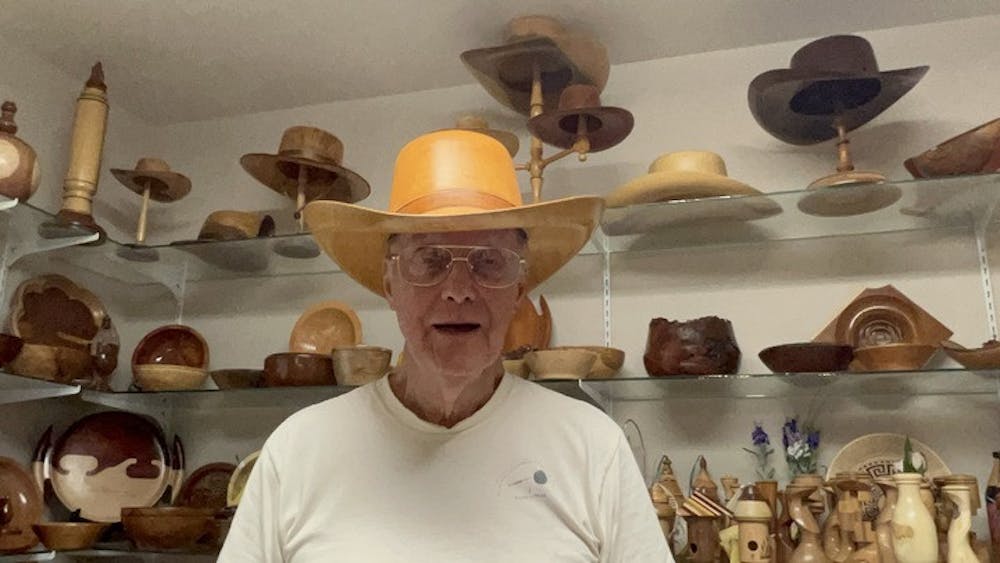In a county marked by its rural character and economic differences, Alamance County has had a slow start to bring together its art community after pandemic restrictions were lifted in June 2021. Artists and event organizers alike have been eager to revive the art scene in Alamance, but have faced challenges in their quest to do so.
Sean Echeverria, supervisor of special events for Burlington, said that the attendance at Burlington art events in the past year has ranged from 750 to over 8,000 people, with popular events such as the Carousel Festival.
With COVID-19 restrictions lifted, Burlington Recreation & Parks Department is able to resume events at pre-pandemic capacity. Echeverria said they are now able to revamp and improve the events put on. The only problem is getting the attendance to match the improvements.
“People are creatures of habit,” Echeverria said. “So if they go to the same event every year, and then they took two or three years off because of COVID, then it’s getting it back on their calendar, making sure that they know, ‘Hey, we’re back.’”
In terms of community engagement, Echeverria said not only is there support from within the department and city council, but also from the community.
“They see the importance of it, they see the need and the desire of people is that they want things to do,” Echeverria said. “They want places to go.”
The federal government allocates funds every year through the National Assembly of State Arts Agencies to 56 state and jurisdictional art organizations in each of the states. The funding mainly relies on demand and the population. According to NASAA, many arts organizations rely on funds from organizations and the government to be able to keep themselves funded.
The NASAA released data in their Legislative Appropriations Preview on both the budget for the fiscal year of 2023 and the proposed budget for the 2024 fiscal year from each state’s arts commission. Compared with the other 49 states, North Carolina’s 2023 budget ranked No. 26 per capita.
The latest NASAA projected budget for the amount of art funding for the fiscal year of 2024 in North Carolina is $9,146,169 — the same exact budget as 2023.
Kathleen Gwinnett, a local painter in Burlington, has been active in the Alamance Arts community for over 30 years. She is also active with Elon University, painting Christmas cards for university President Connie Book, leading a Zoom event for Life at Elon and being commissioned to create Elon landscape paintings for donors.
Gwinnett said she believes the lower level of art participation and funding in Alamance could be caused by the lack of art education in the county. She said she has observed that the lack of sufficient art education has led some to lose the value in art.
“People do appreciate it, but not everybody does,” Gwinnett said.
Rita Zoccolante-Duxbury, a woodturner in Graham, said because of the rural nature of the county and lack of exposure to art compared with other counties, it can be tougher for artists to sell their art.

“The cultural way they look at things is a little different here,” Zoccolante-Duxbury said. “You have to teach people and expose them to different things and make them appreciate it. And they don’t realize it until they get into it themselves.”
In terms of the art literacy in the community, Zoccolante-Duxbury said her and her husband James Duxbury — who is also a woodturner — believe that art is declining and not many people are taking the initiative to expose themselves to it.
“We feel sometimes that we are culturally deprived,” Rita said.
James stressed the importance of participating in art. He pointed out when it comes to more tactile art forms like woodturning, not only is someone making art, but those art pieces can be a useful tool in everyday life.
“Once you do it, we don’t buy anything,” James said. “It’s so much faster to make it and make what you want the way it is and fits your hand or fits whatever you’re doing.”
Gwinnett also emphasized the importance of making sure everyone has access to her art, which she said is why she keeps her prices low.
“I’m just happy that people have them. I don’t want to feel like they can’t afford it,” Gwinnett said.
Alamance Arts Programs Director Kim Williard agreed with Gwinnett in her observations on lack of funds. She said, if increased, the funds would help boost art in the education system in Alamance. Williard added that art education is not just within the confines of the classroom.
“Everybody is moved by some kind of art,” Williard said. “It could be music, listening to the radio, it may not be a visual. It can be painting that you’re moved by.”
According to its 2022-2023 Impact Report, Alamance Arts paid its 135 artists a total of $91,000 — an 81% increase from the previous year. One of their main sources of income was from the government at 37%. The other main sources of income included sales and tickets from events, as well as contributions from the community.
In terms of community engagement, the report revealed that participation from 88 active volunteers with 3,428 collective volunteering hours equaled over $86,000.
One of Alamance Arts’ biggest obstacles, Williard said, is reaching a larger audience. Although it has a solid base of participants and volunteers, Williard said the organization aims to expand its reach to more age groups and demographics.
“I know that our hope is to kind of not break groups apart, but grow groups so that they’re more of the same,” Williard said. “The one thing that can bring people together is art. No matter what you look like, what you believe, looking at a piece of art can bring people together.”


